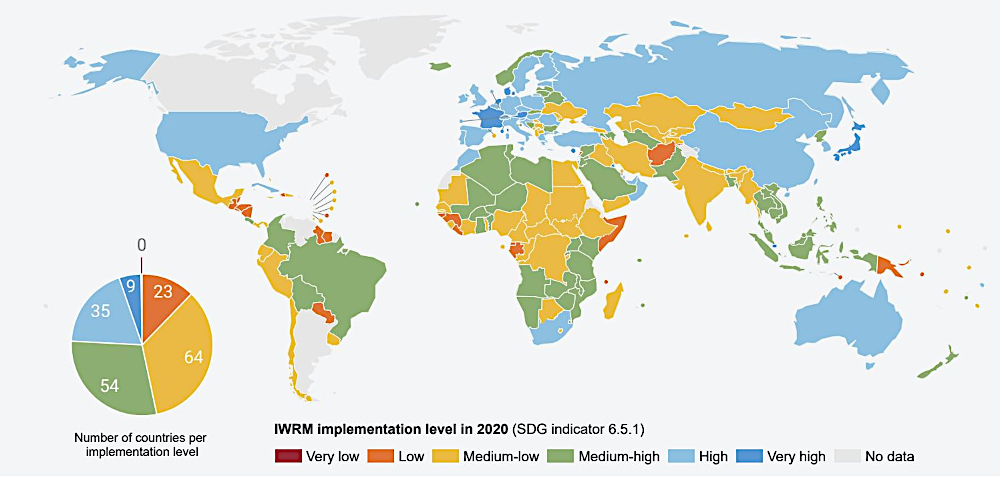Those were among the main findings of the second global progress report on SDG 6.5.1, launched during the 2021 World Water Week, titled “Progress on Integrated Water Resources Management Global indicator 6.5.1 updates and Acceleration needs”. The report highlights the need to strengthen political will for and commitment towards IWRM implementation – at all levels and across sectors – in order to prioritise IWRM as an enabler of and a connector between many other SDGs. It also identified some key success factors and concrete recommendations for different stakeholder groups to be able to boost IWRM implementation. An executive summary of the report is available here in English, Arabic, Chinese, French, Portuguese, Russian and Spanish.
“This monitoring effort is important not just as a periodic ‘IWRM health-check’, but also to identify areas where each country can improve its water management practices, policies and arrangements” says Colin Herron, Global Coordinator, Water Solutions for the SDGs at GWP. “Through the SDG 6 IWRM Support Programme, we are helping countries to turn the opportunities that they themselves have identified in their SDG reporting into actionable and multi-stakeholder investment plans, that can help them on the path towards meeting the goals of the 2030 Agenda. In the next ‘health-check’, we need to see that real progress has been made”.
The results of the global report will be shared in a webinar to be held on September 20th, in two slots, at 9 AM CEST (with Arabic, French and Russian translation) and 5 PM CEST (with French and Spanish translation). The webinar, organised by UN-Water as part of a series focusing on all of the SDG 6 indicators, will provide a platform for all those interested in improving water resources management to be able to reflect upon the priority actions that they can take.
Regional reports
The 2020 Data Drive, which provided input to the global report, is also being used by several regions of the world to review their regional priorities, agree on common actions and increase political support. Central America and the Dominican Republic was the first such region, launching its regional report (Spanish only) and executive summary (ES/EN) in May this year, along with an explanatory video (ES) and infographic (ES). The report contains detailed and specific recommendations for every country in the region to advance on IWRM implementation in the coming years, as well as regional strategies that can catalyse such recommendations. It was produced jointly with the Central American Commission for Environment and Development (CCAD), and the focal points from each of the countries.
“The links with IWRM are increasingly relevant and the regional report highlights the challenges countries must face to accelerate water management. Thanks to tools like this report, we as decision makers can feel more comfortable in promoting this call to action with balanced decisions between vision and reality” said Andrea Meza, Minister of the Environment of Costa Rica and the current chair of the CCAD. “Having clear targets is important to mobilise resources that allow IWRM milestones to be reached”.
The second such regional report, from the Pan-Asian region, was launched during the 2021 World Water Week, at the Asia Focus: Accelerating inclusive water governance to advance sustainable development, and contains both a full report and an executive summary, both in English. The report calls on all stakeholders to rally around integrated action, in line with existing commitments in the region, not just to the SDGs, but also to the Yangon declaration from heads of state at the 3rd Asia-Pacific Water Summit in 2017, which commits the countries to “facilitate the implementation of integrated water resources management at all levels, including through transboundary cooperation, as appropriate, and partnerships.” The more detailed results of the Pan-Asian report will be shared in a forthcoming webinar.
Please register here if you would like to be kept informed about that event, and other activities organised through the SDG 6 IWRM Support Programme.
Thematic reports
Thematically, we have also been diving into the results of the SDG 6.5.1 survey instrument. The first such report to be produced is Advancing towards gender mainstreaming in water resources management, available both as a main report and a policy brief. The report presents the current status of the gender-related question in the survey, at 54 out of 100, shares many relevant country experiences that other countries may learn from, and highlights seven key enablers, based on the analysis of country responses, that would allow countries to advance in this sense, irrespective of where they currently stand.
Other regional and thematic reports and summaries on SDG 6.5.1 are currently under preparation, as more regions look to build upon the monitoring exercise to boost action and political support towards enhanced IWRM implementation. All interested stakeholders can also access the official country submissions and country summaries on the IWRM Data Portal, the latter available in different languages.
The top image is a figure from the global progress report.

